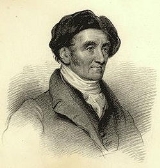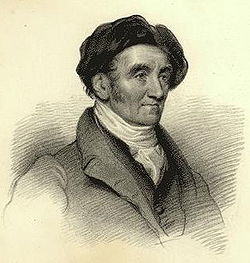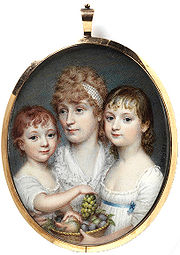
Charles Hayter
Encyclopedia


Portrait miniature
A portrait miniature is a miniature portrait painting, usually executed in gouache, watercolour, or enamel.Portrait miniatures began to flourish in 16th century Europe and the art was practiced during the 17th century and 18th century...
in London, and also Essex, and in 1832 in Winchester. He exhibited 113 portrait miniatures between 1786 and 1832, principally at the Royal Academy and had a reputation for getting a good likeness.
Hayter married Martha Stevenson in 1788 and his two sons and daughter were all successful artists; Sir George Hayter
George Hayter
Sir George Hayter was a notable English painter, specialising in portraits and large works involving in some cases several hundred individual portraits...
(1792–1871), John Hayter
John Hayter
John Hayter was an English portrait painter. He was the second son of the miniaturist Charles Hayter and brother of Sir George Hayter, also a portaitist. He entered the Royal Academy schools in 1815, and began to exhibit at the Royal Academy in the same year. He also exhibited work at the British...
(1800–1895), and Anne Hayter who, like her father, was a miniature painter.
Charles Hayter taught perspective (on which he was an authority) to Princess Charlotte
Princess Charlotte Augusta of Wales
Princess Charlotte of Wales was the only child of George, Prince of Wales and Caroline of Brunswick...
, King George IV's daughter, to whom he was later appointed Professor in Perspective and Drawing. He also dedicated to her, his book "An Introduction to perspective, adapted to the capacities of youth, in a series of pleasing and familiar dialogues" first published in 1813 in London. He later published "A New Practical Treatise on the Three Primitive Colours Assumed as a Perfect System of Rudimentary Information" (London 1826) in which he described how all colours could be obtained from just three.
An album containing 443 studies for miniature portraits is in the V&A. Hayter noted inside the cover that these were sketches which he 'placed behind the Ivory, which being transparent, gave the artist the aid in making his outline on the ivory'.
----

